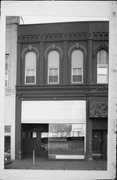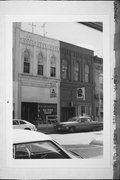| Additional Information: | The Francis Dry Goods Store was erected in 1869 by James Francis and was occupied by Francis until at least 1875. From 1875 to 1889, little is known about the history of this building or how long the James Francis Dry Goods store operated here.
By 1889, the Francis Dry Goods Store building was occupied by an unknown hardware store.
Thereafter, the building housed a number of saloons and restaurants. From 1897 to 1911, it was a C.J. Abrahamson's saloon, which was associated with John Gund Brewing, who paid the taxes on the building. By 1911 to at least 1922 it was the White Buffet Resturant/Saloon with the taxes being paid by Gund Brewing until 1920.
The Francis Dry Goods Store Building gain slocal significance under Criteria A in association with the topic General Merchandise, Dry Goods and furniture Store under Sparta's Commerce Theme. The building's period of significance ranges from 1869 to 1875. Little is known about the occupants of the building from 1875 to 1889. After 1889, there were several businesses located in the building that are not well documented and it is not clear at this time if the dates of significance should be extended beyond 1875.
This small vernacular Romanesque Revival influenced commercial building is a two-story, three-bay, brick building [presently painted] characterized by a plain cornice visually resting on the applied pilasters that divide the facade into three recessed bays. The facade is further characterized by round arches forming an arcade in the brick work above the arched windows and below the cornice. Raised round arched window heads with articulated keystones and corbel stops ornament the three windows in the compartmentalized facade. In addition, a lessor cornice featuring brick mouldings and a row of dentil trim is located above the storefront. A contemporary storefront with an off-set recessed entrance is located on the lower story.
This small mid-19th century retail building has been altered by the replacement of the windows with smaller metal windows and partially with wooden panels. The brick entablature, now plain, originally had a cornice composed of slightly projecting brick mouldings and a small brick parapet. In the early 20th century, the building displayed an additional cornice topped by a small rectangular pediment, which early photographs indicate was not original to the building. This vernacular brick building has also been altered by the addition of a contemporary storefront.
Constructed in 1869 to replace a frame building on the site, this building, built for J. francis, was partially reconstructed in the same style in 1876-77 when damaged by a fire in September, 1876, that destroyed the adjacent frame Helelr building on the corner of Oak and Main and several blocks of mostly frame buildings located east and north of it. Constructed on a stone foundation at the same time and in the same manner as the adjacent Foster building at 107 West Oak (MO34/2) by local carpenter/builder J.H. Atty, these two buildings were described when built as a "truly ornamental," and "painted deep red and beautifully penciled with white paint, white keystones in the arches above the doors and windows...all buildings should be painted and lined...also prevents wear and tear." The iron "shafts and pillars" on the original store front were made at the Sparta Foundry on East Oak. This small brick building originally housed the Francis and Stoppe, known previously as Perry and Francis, Dry Goods and Grocery Store.
The Francis Dry Goods Store does not meet the Criteria of the NRHP for architectural significance because of a lack of integrity. Although this small commercial building continues to exhibit much of its vernacular Romanesque Revival character, its architectural significance has been altered by the replacement of its windows with small windows and wood panels. However, this building has sufficient historic architectural character to contribute to the Water Street Historic District. Better preserved examples of the Romanesque Revival include the Monroe County Court House at 108 South Court (MO36/28) and the Hoffman Building at 107-108 South Water (MO36/12). |
|---|
| Bibliographic References: | (A) Monroe County History Room, Rt. 2, Sparta, Photograph Collection, Photograph #396, #1428.
(B) City of Sparta Tax Records, 1868-1930.
(C) Sparta Herald April 13, 1869; May 11, 1869; May 18, 1869; July 3, 1869; July 13, 1869; Aug. 17, 1869; Oct. 4, 1870; Oct. 10, 1876; Dec. 19, 1876.
(D) Sanborn Insurance Maps 1884, 1889, 1894, 1900, 1911, 1922, 1931.
(E) City of Sparta Property Tax Rolls, 1870-1940.
(F) Map of Sparta, Wisconsin. Milwaukee: Phoenix Map Company of Milwaukee, 1875.
(G) French, Bella, "History of Sparta, Wisconsin." The American Sketchbook. La Crosse: Sketch Book Company, Publishers, 1875, p. 70-74.
(H) Annual Directory of Sparta, Wisconsin. Vol. 1. Chicago: Interstate Directory Co., 1897.
(I) Sparta City Directory, 1903-1904. Sparta: R.C. Glover, Publisher, 1904.
(J) City Directory of the City of Sparta, Wisconsin. Sparta: compiled and published by E.B. Bell, 1916. |
|---|


